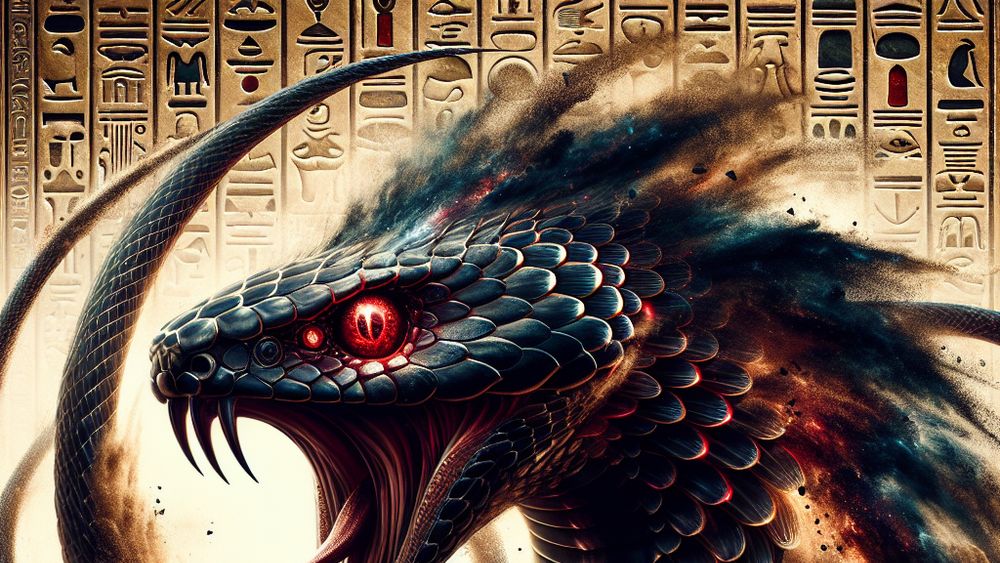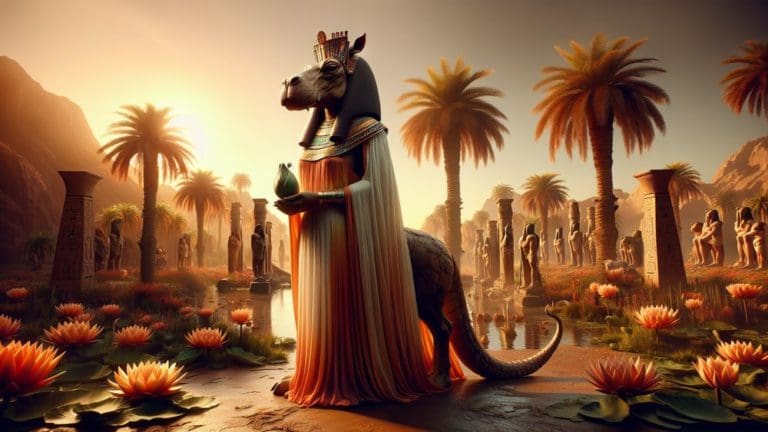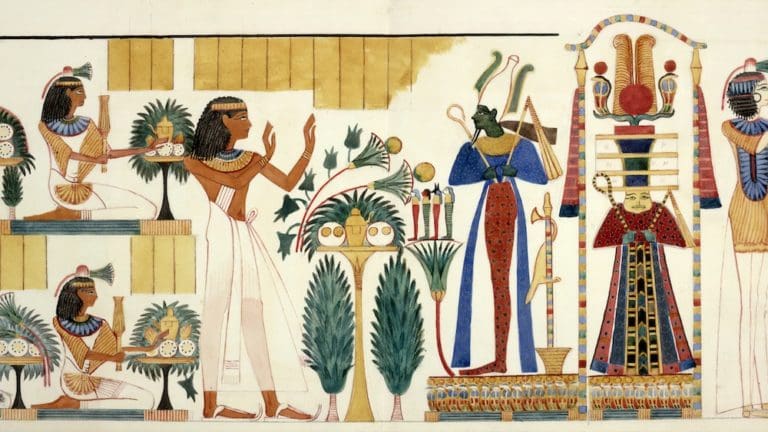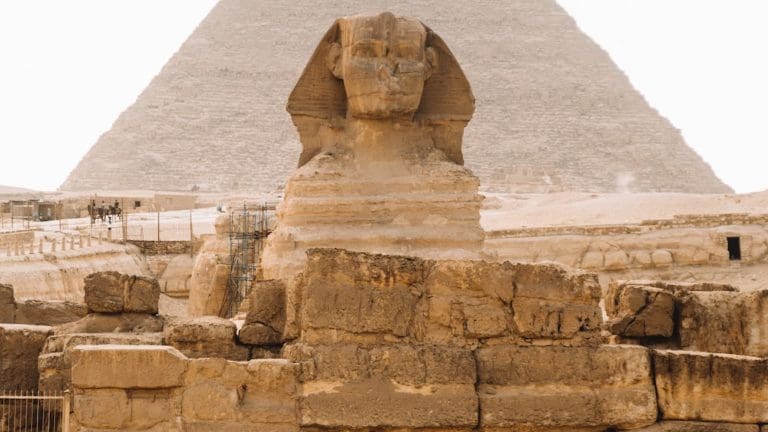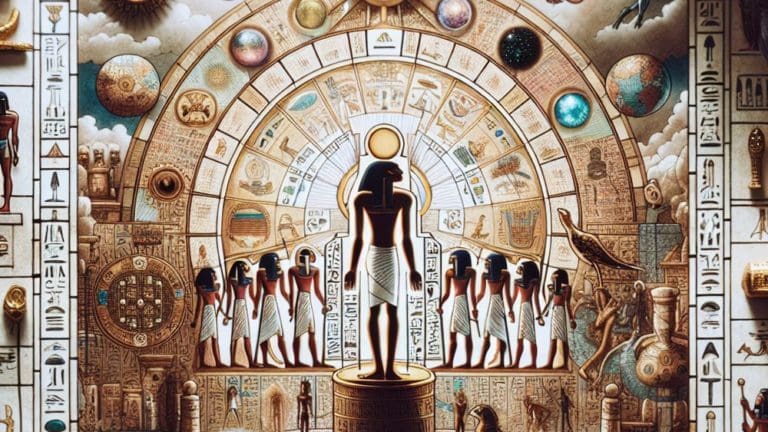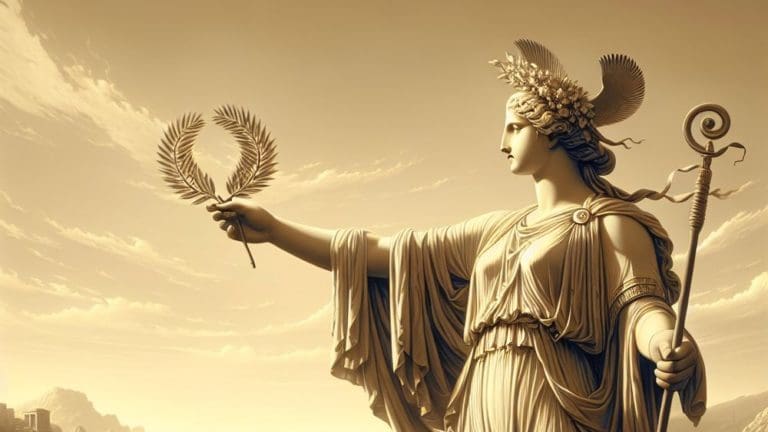The Ultimate Guide To Apep, The Great Snake Of Chaos
The Ultimate Guide To Apep, The Great Snake Of Chaos
Apep, The Great Snake of Chaos, is one of Egyptian mythology’s most intriguing figures. Steeped in mystery and always ready to stir the pot, this ancient serpent embodies chaos itself. For those who dig history and mythology, Apep’s story is like finding a hidden gem in the sandy expanse of Egypt’s past.
Key Points:
- Apep, The Great Snake of Chaos, embodies chaos and darkness in Egyptian mythology.
- Apep, also known as Apophis, is the arch-nemesis of sunlight, order, and creation.
- Apep symbolizes the eternal battle between order and chaos in Egyptian mythology.
- Apep engages in epic daily battles with Ra, the sun god, to swallow the sun and bring eternal darkness.
- Ancient Egyptians used rituals, magic spells, and imaginary weapons to defeat Apep and protect the sun.
- Apep’s influence extends to modern culture, appearing in films, books, and video games.
- Apep’s essence of chaos finds parallels in contemporary chaos theory, emphasizing the unpredictability of small disturbances.
Diving into this tale, you’ll uncover more than just myths. You’ll find stories of epic battles, symbols of good versus evil, and insights into ancient Egyptian life. This isn’t just any old snake tale. It’s a deep dive into the heart of chaos, where Apep clashes with gods and humanity alike. And trust me, it’s awesome.
The Mythological Essence of Apep
At the core of Apep’s story, you find chaos, darkness, and a dash of the eternal fight against order. This serpent isn’t just another character; he’s the embodiment of all that ancient Egyptians feared in the unpredictable, dark void.
Origins and Mythological Background of Apep
Apep, also known as Apophis, is no small fry. He’s the arch-nemesis of sunlight, order, and creation itself. Born from the deepest parts of the underworld, every Egyptian knew his name and what it stood for.
We’re talking about a serpent of unimaginable size, darkness, and power. Here’s a quick rundown:
- Origin: Sprung from the depths of chaos.
- Size: Enormous, capable of encircling the world.
- Enemy number one: The sun god, bringing light and life into the world.
- Ultimate goal: To devour the sun and plunge the world into eternity of darkness.
Apep, also known as Apophis, is a formidable serpent born from chaos, seeking to devour the sun and bring eternal darkness.
Apep’s Role in Egyptian Mythology
In the grand scheme of Egyptian mythology, Apep played the essential role of the antagonist. His presence was a constant reminder of the balance between order and chaos.
Here’s what he was all about:
- Antagonist: Forever in battle with Ra, the sun god.
- Symbol of chaos: Representing the eternal fight against the order of the universe.
- Fear embodiment: A presence that kept both gods and humans on their toes.
Symbolism and Interpretation of Apep
Apep wasn’t just a big bad snake; he was a symbol. To the Egyptians, he represented the darkness within and the fears they had to conquer. His battles with Ra depicted the never-ending cycle of night turning into day, chaos giving way to order, and evil being overcome by good.

In essence, Apep reminded everyone of the darkness that waits for its chance to swallow the light. But, likewise, he showed that light always finds a way to shine through.
Remember, like Apep, darkness within us symbolizes the fears we must conquer, but just as light overcomes darkness, our inner light will always shine through.
Apep’s Adversaries and Epic Battles
When Apep rampaged, all of Egyptian mythology braced itself. His battles weren’t just fights; they were epic sagas of good against evil, light clashing with darkness, and the fragile balance of the universe at stake.
The Eternal Battle with Ra
Each day was a battlefield for Apep and Ra, the sun god. This wasn’t just any spat; it was an epic, daily showdown with the fate of light and life on the line.
Here’s the rundown:
- Setting: The sky, just before dawn.
- Participants: Apep, the giant serpent of chaos, versus Ra, the majestic sun god in his solar barge.
- Objective: For Apep, swallow the sun and plunge the world into eternal darkness. For Ra, defeat Apep and rise again, bringing light and life.
- Outcome: Though Apep strives to devour the sun each night, Ra, with the help of protective deities like Sekhmet, always emerges victorious, ensuring the sun rises each day.
Allies of Apep in the Egyptian Pantheon
Not to shock you, but Apep didn’t have a fan club among the gods. However, some myths whisper of minor deities and dark forces that aligned with him. These allegiances were more about sowing chaos than about deep friendships. Think of them as the acquaintances you only call when planning mischief.
In texts referring to Apep, there’s mention of demons and nocturnal creatures supporting him in the underworld. Their goal was simple: bring darkness over light, chaos over order. They were not exactly the party folks within the Egyptian pantheon but played a crucial role in Apep’s battles against Ra.
Alliances with dark forces and minor deities aligned with Apep were focused on sowing chaos over friendship within the Egyptian pantheon.
Methods and Weapons Used to Defeat Apep
Here’s a cool fact: the ancient Egyptians were super innovative when it came to dealing with Apep. They used magic, mighty spells, and even physical weapons imagined in text and ritual to keep the serpent at bay. It wasn’t just any fight; it was an epic cosmic battle happening every night.
Among the methods to defeat Apep, rituals played a key role, invoking powerful gods like Ra and Sekhmet to intervene. Magical spells were inscribed on amulets and in texts, providing protection and helping in the eternal battle against chaos. Let’s put some of this awesome stuff into a table, shall we?
| Method | Description |
|---|---|
| Rituals | Invocations and ceremonies to strengthen the sun god and weaken Apep. |
| Magic Spells | Spells cast to protect the barge of the sun god and to repel Apep into the depths of the underworld. |
| Physical Weapons | Imaginary weapons, like the mystical harpoon, believed to be used by Ra against Apep. |
The Cultural Impact of Apep
The story of Apep didn’t just scare kids at bedtime. It had a deep impact on Egyptian culture, influencing art, literature, and the way they viewed the cosmos. This serpent symbolized chaos itself, pressing the importance of order and harmony in the world. It’s fascinating how a myth can shape the way people see their universe, right?

Apep in Ancient Egyptian Art and Literature
Apep, the daunting serpent, slithers its way through ancient Egyptian art and literature, captivating and horrifying. Here’s the thing:
- Pyramid Texts – These ancient texts are like the old-school version of your favorite horror story, detailing the sun god’s battle with Apep.
- In tomb art – Apep is often depicted being defeated or restrained, which was a visual representation of the daily victory of light over darkness.
This depiction served as a potent symbol of the eternal struggle between order and chaos, resonating deeply with the Egyptian understanding of the universe’s balance.
Modern Interpretations and References to Apep
Guess what? Apep has snaked its way into modern culture too. Yes, the ancient symbol of chaos and darkness finds itself in films, books, and even video games. Here’s an example:
Modern writers and directors play with the myth of Apep to depict battles between good and evil, chaos and order. This ancient foe of light provides a chilling metaphor for human struggles against the dark forces, both literal and metaphorical.
Artists and game developers draw on the visceral imagery of Apep to craft villains and obstacles for heroes, bridging ancient mythology with contemporary tales of adventure and heroism.
Apep’s symbolism in modern culture bridges ancient mythology with contemporary tales of heroism and adventure.
The Influence of Apep on Contemporary Chaos Theory
Okay, so here’s the deal: though Apep is ancient history, its essence of chaos has found a parallel in modern chaos theory. This isn’t about snakes and sun gods, but the idea that small disturbances can lead to significant, unpredictable changes. Apep’s representation of disorder echoes the sensitivity to initial conditions found in the natural world and human society, a concept deeply rooted in the principles of chaos theory. Isn’t it awesome how things connect?
FAQs
1. How did the ancient Egyptians protect themselves from Apep?
To protect themselves from Apep, the ancient Egyptians performed daily rituals. These rituals involved the creation of spells, reciting of chants, and making of magical amulets. All these were thought to ward off the darkness and chaos Apep brought into the world.
2. What are the most famous myths involving Apep?
The most famous myths involving Apep center around his eternal battle with Ra, the Sun God. In one popular narrative, Apep attempts to swallow the sun barge each night, preventing the sun from rising and plunging the world into darkness. Ra, with the help of other gods, must defeat Apep and ensure the sun rises each day.
3. How is Apep depicted in ancient Egyptian art?
In ancient Egyptian art, Apep is depicted as a gigantic serpent, often engulfed in battle with Ra or being subdued by other gods. This representation symbolizes the chaos and darkness that Apep brings against order and light. Sometimes, Apep is shown being chopped into pieces or under the foot of a deity, illustrating his defeat.
4. Can Apep be considered a deity?
While Apep represents a powerful force in Egyptian mythology, he is not traditionally considered a deity. Rather, Apep embodies the antithesis of ma’at (order, truth), the chaos, and destruction opposing the creation and harmony fostered by the gods. His existence is crucial to the balance between order and chaos in the cosmic cycle.
Conclusion
Apep, The Great Snake of Chaos, embodies more than just a mythological villain; he represents the eternal struggle between light and darkness, order and chaos. This dichotomy is not just ancient history; it resonates in modern understandings of the universe and humanity’s place within it. Each night’s victory over Apep was a reminder that light, life, and order would always prevail. I get it, mythology can be heavy sometimes, but diving into the awesome tales of Apep and the gods of Egypt? Totally worth it.
Thank you for joining me on this journey through ancient tales and modern interpretations. Catch you on the next adventure into the past!
Cedric

